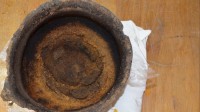 A clay pot discovered during an archaeological excavation near Silkeborg in central Jutland, Denmark, in 2012 has the residue of 3,000-year-old burned cheese coating the interior. The pot was found upside down in a garbage pit. Museum Silkeborg archaeologists were excited by the find because the pot was intact and in near mint condition, a rare find for a Bronze Age vessel made between 777 B.C. and 588 B.C. They didn’t realize until they cleaned the soil off of it that the crusty remains of some whitish yellow food substance were stuck to the inside walls.
A clay pot discovered during an archaeological excavation near Silkeborg in central Jutland, Denmark, in 2012 has the residue of 3,000-year-old burned cheese coating the interior. The pot was found upside down in a garbage pit. Museum Silkeborg archaeologists were excited by the find because the pot was intact and in near mint condition, a rare find for a Bronze Age vessel made between 777 B.C. and 588 B.C. They didn’t realize until they cleaned the soil off of it that the crusty remains of some whitish yellow food substance were stuck to the inside walls.
The color and texture were not something the archaeologists had seen before. Charred grains and seeds are a more common sight in ancient cookware — the ever-tricky porridge has been getting burned to the bottom of pots for thousands of years — but the yellowish film was a mystery. Samples of the crusty substance were subjected to macrofossil analysis at the Moesgaard Museum in the hope it might identify any plants, meat or fish. The results were inconclusive. The test found the substance was a foamy, vitrified material, possible the residue of oil or sugar.
 Museum curators sent samples to the Danish National Museum next, where chemist Mads Chr. Christensen used mass spectrometry to identify the substance. He was able to narrow it down to a product made with the fat of a ruminant, likely bovine. With no similar sample to compare the mass spectrometry results, he wasn’t able to get more specific than that.
Museum curators sent samples to the Danish National Museum next, where chemist Mads Chr. Christensen used mass spectrometry to identify the substance. He was able to narrow it down to a product made with the fat of a ruminant, likely bovine. With no similar sample to compare the mass spectrometry results, he wasn’t able to get more specific than that.
“The fat could be a part of the last traces of curds used during the original production of traditional hard cheese. The whey is boiled down, and it contains a lot of sugars, which in this way can be preserved and stored for the winter,” says [Museum Silkeborg curator Kaj F.] Rasmussen.
“It is the same method used to make brown, Norwegian whey cheese, where you boil down the whey, and what’s left is a caramel-like mass that is turned into the brown cheese that we know today from the supermarket chiller cabinet,” he says.
When things don’t go according to plan and the cheese burns to the pot, the smell is pungent, to put it charitably, and attempts to scrape the foul crust off the clay pot doomed to failure. It’s easy to picture a Bronze Age cheesemaker dumping the whole mess into the trash.
I’m not familiar with brown Norwegian whey cheese. It sounds … interesting. Has anybody tried this delicacy?